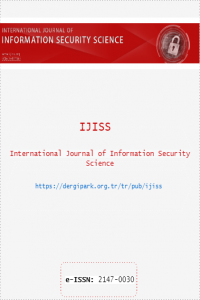Review of Evidence Collection and Protection Phases in Digital Forensics Process
Review of Evidence Collection and Protection Phases in Digital Forensics Process
___
- [1] Ş. Sağıroğlu, M. Karaman. “Adli Bilişim”. Telepati, Vol. 203, pp. 62, August, 2012.
- [2] Y. Kim and K. J. Kim, “A Forensic Model on DeletedFile Verification for Securing Digital Evidence”. 978—1- 4244-5493-8710 IEEE, 2010.
- [3] http://www.ekizer.net. “Adli Bilişim (Computer Forensics)”, Latest Access Time for the website is 14 October 2016.
- [4] M. Özen, G. Özocak, “Adli Bilişim, Elektronik Deliller ve Bilgisayarlarda Arama ve El Koyma Tedbirinin Hukuki Rejimi (CMK M. 134)”. Ankara Barosu Dergisi, 2015.
- [5] M. Z. Gündüz, Bilişim suçlarına yönelik IP tabanlı delil tespiti- IP-based Evidence Detection, Master Dissertation, University of Fırat 2013.
- [6] M. Orta, Bilişim Suçlarında Adli Analiz, Ph.D Dissertation, University of Selçuk 2015.
- [7] L. Keser Berber, Adli Bilişim. Yetkin Publisher/Ankara, 2004.
- [8] http://slideplayer.biz.tr/slide/1918963. Y. Uzunay, “Dijital Delil Araştırma Süreci”, Latest Access Time for the website is 14 October 2016.
- [9] E. Casey, Digital Evidence and Compter Crime Scene. ABD/AP, 2004.
- [10] T. Henkoğlu, Adli Bilişim Dijital Delillerin Elde Edilmesi ve Analizi, Pusula Publisher/İstanbul, 2014.
- [11] Y. Başar, Siber Suç Soruşturmalarında Adli Bilişim İncelemeleri, Master Dissertation, University of Kocatepe 2015.
- [12] R. Adams, V. Hobbs, G. Mann. “The Advanced Data Acquisition Model (ADAM): A Process Model for Digital Forensic Practice”. Journal of Digital Forensics, Security and Law, JDFSL. Vol. 8, No. 4, pp. 25-48, 2013.
- [13] R. J. Vacca, Computer Forensics, Second Edition, Charles River Media, IBSN: 1–58450–389–0, 2005.
- [14] M. Kaygısız, Kriminalistik Olay Yeri İnceleme Suç Yeri ve Delil Güvenliği, Adalet Publisher, 2007.
- [15] http://www.chip.com.tr/forum/Bilisim-SuclarininDelillendirilmesi_t8007.html. “CHIP Online”, Latest Access Time for the website is 6 October 2016.
- [16] H. Aydoğan, Adli Bilişim'de Yeni Elektronik Delil Elde Etme Yöntemleri, Master Dissertation, Institute of Police Academy Security Sciences 2009.
- [17] G. Kessler, G. Carlton. “A Study of Forensic Imaging in the Absence of Write-Blockers”. Journal of Digital Forensics, Security and law, JDFSL, Vol. 9, No. 3, pp. 51-58, 2014.
- [18] http://www.difose.com.tr/blog/index.php/testler/89- solid-state-disk-adli-kopyasi. “DIFOSE Digital Forensics Services”, Latest Access Time for the website is 6 November 2016.
- [19] A. Ekim, Bilişim Suçlarında Sayısal Delillerin Toplanması, Muhafaza Edilmesi, İncelenmesi ve Raporlanması, Master Dissertation, University of Marmara 2013.
- [20] M. Ukşal, Mobil Cihazlarda Adli Bilişim, Master Dissertation, University of İstanbul Bilgi 2015.
- [21] L. Tobin, P. Gladyshev. “Open Forensic Devices”, Journal of Digital Forensics, Security and law, JDFSL., Vol 10, No. 4, pp. 97-104, 2015.
- [22] R. V. Voorst, M.-T. Kechadi, N.-A. Le-Khac. “Forensic Acquisition of IMVU: A Case Study,” Journal of Digital Forensics, Security and Law, JDFSL, Vol. 10, No. 4, pp. 69-78, 2015.
- [23] F. Breitinger, İ. Baggili. “File Detection on Network Traffic Using Approximate Matching”, Journal of Digital Forensics, Security and Law, JDFSL, Vol. 9, No. 2, pp. 23-36, 2014.
- [24] M. S. Kılıç. Elektronik Deliller ve Yapısal Özellikleri. Edit: H. Çakır and M.S. Kılıç. Adli Bilişim ve Elektronik Deliller, Seçkin Publisher/Ankara, 2014.
- [25] D. Chang, S. K. Sanadhya, M. Singh. “Security Analysis of MVHASH-B Similarity Hashing”. Journal of Digital Forensics, Security and Law, JDFSL, Vol. 11, No. 2, pp. 21-34, 2015.
- [26] J. Eggestein, K. Knapp. “Fighting Child Pornography: A Review of Legal and Technological Developments”.Journal of Digital Forensics, Security and Law, JDFSL, Vol. 9, No. 4, pp. 29-48, 2014
- Yayın Aralığı: Yılda 4 Sayı
- Başlangıç: 2012
- Yayıncı: Şeref SAĞIROĞLU
Atila BOSTAN, Gökhan ŞENGÜL, K. Murat KARAKAYA
Efficient Big Integer Multiplication in Cryptography
Murat Burhan İLTER, Murat CENK
Ransomware Analysis and Defense-WannaCry and the Win32 environment
Review of Evidence Collection and Protection Phases in Digital Forensics Process
